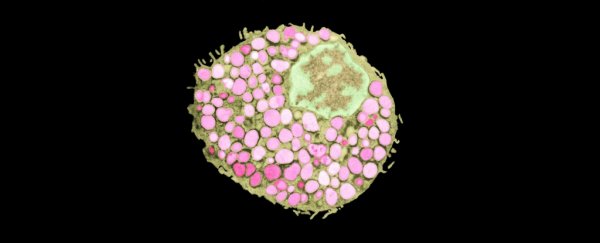Allergies can be deadly. But despite how common they are, scientists still don't fully understand what happens inside the body to trigger anaphylactic shock - a terrifying and rapid reaction that can result in death.
But they're getting closer. For the first time, scientists have identified a mechanism in mice that sends a body into full-on panicking shutdown when exposed to even the smallest amount of an allergen.
An allergy occurs when the body's immune system mistakenly identifies a particular substance - such as peanuts, or shellfish - as harmful, and fires up to fight it, potentially triggering anaphylaxis.
Anaphylaxis is incredibly dangerous. It's the most serious of all the allergic reactions, and it can happen incredibly quickly. Within minutes of allergen exposure, the patient's immune system can kick into action - causing facial swelling, racing heart, rashes and hives, and the inability to breathe.
We know that a type of immune cell called a mast cell plays a central role in anaphylaxis. When an allergen is detected, these cells release inflammatory molecules such as histamines, which play an important role in the inflammatory response, one of the body's defense mechanisms.
But until now, exactly how how the presence of the allergen is communicated between mast cells, and so quickly, had been something of a mystery. The new study implicates immune cells called dendritic cells.
"The central finding is that dendritic cells, which are key players in allergy development, also play a direct role in triggering anaphylactic shock," said immunologist and senior author Soman N. Abraham of Duke University.
To figure this out, the researchers lowered the levels of different types of immune cells in mice, then injected them with toxins to induce anaphylaxis.
They found that the mast cells on their own weren't able to pick up allergens. And when a certain type of cell - the dendritic cell - was reduced, the mice didn't experience anaphylactic symptoms.
When they looked closer with two-photon microscopy, the researchers observed these dendritic cells in action. They're called dendritic cells because of their dendrites, which are long tendrils they can use to probe into other cells.
As they sit on the exterior surface of blood vessels, they use these dendrites to penetrate the cell wall, seeking out invading substances.
Upon detection of an allergen, they communicate its presence to any surrounding mast cells - but the way they do this is pretty weird.
Usually, when dendritic cells detect antigens, they internalise them, process them, and present information about the antigen on their surface to communicate it to the immune system's T cells so they can get to work.
These dendritic cells fish the allergen out of the blood vessels, then send it out via tiny bubbles called microvesicles, which bud from the surface of dendritic cells.
"In addition to their well-known capacity to internalise, process and present antigens to immune cells, dendritic cells now appear to actively distribute antigens they have acquired to surrounding immune cells even before they are internalised," Duke University immunologist Hae Woong Choi explained.
This method spreads information much more quickly, and to a larger number of cells. And when they receive the microvesicles, the mast cells are galvanised into action, filling the blood stream with histamines and other inflammatory mediators, kicking off anaphylaxis.
Obviously, we don't know if it works exactly the same in humans. And nor do we know if these dendritic cells are somehow beneficial. These things will need to be figured out - but once they are, this research could help develop a new way to prevent anaphylaxis.
"While it's detrimental in the context of allergens, this function might be needed to fight diseases and actually be helpful," Abraham said.
"Maybe these dendritic cells are designed to detect blood-borne parasites, viruses or bacteria, so we need to understand any other circumstances that activate them before contemplating shutting them down or impeding their activity."
The team's research has been published in the journal Science.
